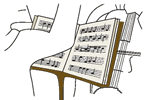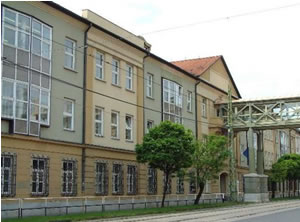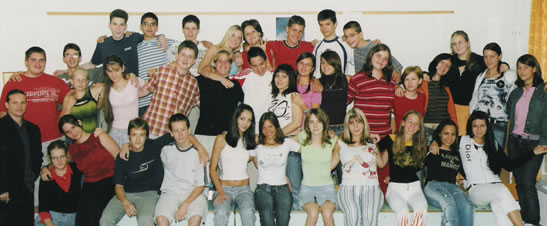Introduction to Dora Kovács"
case study
by Antoinette Camilleri Grima
|
|
In her case description,
Dora Kovács, the Head teacher of the Herman
Ottó Grammar School in Hungary, focuses
on the offer of foreign language education as
part of a cross-curricular bilingual programme
(KovacsGraz.ppt).
She raises a few significant issues which are
of direct relevance to the proposals and explanations
presented in the Guide (Guide_ACG.ppt).
|
This school like some others in Hungary and elsewhere has
initiated a culture of transformation in the way foreign language
education is perceived and provided. Setting up curricula
that follow the guiding principle of plurilingualism as expressed
in the Guide "will certainly be a gradual process, as
it involves transforming curricula and mentalities"
(the Guide, p. 68), and so one should be encouraged
by the fact that both national and regional authorities have
embarked on projects like the one described here, which already
go some way foreword from the curricular offer of foreign
languages as separate subjects just over a decade ago.
Moving towards a relatively balanced bilingual curriculum
plus another foreign language is a step towards plurilingualism.
The following are some of the indicators that highlight progress
in this case description:
- The plurilingual option is in great demand. The
Guide states that "creating the external
conditions favourable to the plurilingual idea is a collective
task which requires training…and will probably need
support from social intermediaries" (p. 70).
In Hungary, as explained here, it was not difficult to find
support for such programmes. There is so much competition
to enter these programmes among students that a competitive
entry examination had to be established. It is also
made clear here that the regional and national governments
support these bilingual programmes in certain ways, including
through financial aid. These innovations can be eventually
extended to more advanced forms of plurilingual education,
once the climate is set in favour of a diversified language
provision.
- Bilingual programmes in schools like this one have started
a "decompartmentalisation" process. The
Guide would like to see language education as a
related concern to other subjects like literature, philosophy,
history, geography and citizenship education (p. 67), and
as explained in section 6.4 it is necessary to decompartmentalise
the process of teaching languages as separate subjects in
competition with each other. By aligning foreign language
learning with a choice of subjects that were not previously
associated with languages, is one way of changing the mentality
that a foreign language is simply another subject on the
school time-table, and therefore brings home the idea that
languages are valuable, and that they "can be taught
in ways that are functional" (Guide, p. 62).
- Proficiency in foreign languages has great relevance
to university course requirements and career prospects
(Guide, p. 62). Students who are very
eager to participate in bilingual education, and who
work hard to achieve good grades, cannot be blamed
if they see this as a means of obtaining admittance
to their choice of university courses, and eventually
to the careers and professions they would like.
In this case, the special focus on the foreign language
is meant for a certain type of student - and
is criticised, for example by Kapintanffy (Kapitanffy.doc)
possibly as a form of elitist education. But
surely the solution can only be found in extending
the programme and in diversifying the offer in other
schools, and not in discontinuing a successful and
welcomed project (Lakesandrivers_results)
.
|
 Bilingual
education in the Herman Ottó Grammar School Challenges, Opportunities
and Difficulties Bilingual
education in the Herman Ottó Grammar School Challenges, Opportunities
and Difficulties
Dora Kovács
The School
 Herman
Ottó Grammar School is situated in Miskolc, the third biggest
town of Hungary and the cultural centre of the North-East. The school
has 860 pupils, boys and girls in equal proportions. It is one of
the most prestigious grammar schools of the region particularly
as far as humanities are concerned. In 1994 the school moved into
a new building. The spacious and harmonious environment made the
school even more popular with students and their parents. Herman
Ottó Grammar School is situated in Miskolc, the third biggest
town of Hungary and the cultural centre of the North-East. The school
has 860 pupils, boys and girls in equal proportions. It is one of
the most prestigious grammar schools of the region particularly
as far as humanities are concerned. In 1994 the school moved into
a new building. The spacious and harmonious environment made the
school even more popular with students and their parents.
The Linguistic Context
The Herman Ottó Grammar School has, for a long time, enjoyed
a good reputation for providing a high standard of foreign language
education in Russian (up to the 1990s), English, German and French.
Latin has also been taught since the beginning, although nowadays
interest in learning Latin has diminished. Since the year 2000 pupils
have also been able to learn Spanish. Hungarian, the mother tongue
of some 15 million people, is considered to be a very difficult
language for foreigners, and so Hungarians generally feel the need
to speak one or more foreign languages. This motivates language
learning in the educational system: the first foreign language must
be introduced at the latest at the age of ten, but very often language
learning starts much earlier, i.e. in the first year of schooling
(at the age of six/seven). All secondary school pupils are
expected to pass the school leaving (A level type) examination in
at least one foreign language. In grammar schools, two foreign languages
are compulsory and no university degree can be obtained without
a qualification in two foreign languages (state approved language
exam certificates are demanded for admission to universities).
The Language Background of our pupils
Hungary is mostly a monolingual country i.e. most people
speak Hungarian. Immigration is a rather insignificant issue
at national level. Minorities (Slovak, Romanian, German, Serb
and Croatian) living in Hungary are relatively small in terms
of population, and live mostly in rural areas. This means
that the mother tongue of the majority of our pupils in the
Herman Ottó Grammar School is Hungarian. Our
pupils are very strongly motivated to learn Western European
languages, and our teachers can truly rely on this motivation.
A large number of our pupils obtain language examination certificates
in two foreign languages at the point of leaving our school,
and this is an asset for them as far as admission to university
is concerned (School profile).
National
policy for language education
The national policy for language education entertains different
options. Language learning starts at elementary level with at least
three lessons per week but there is a strong tendency to offer specialised
classes where the number of lessons can reach 5 per week. Very few
elementary schools propose the simultaneous acquisition of two foreign
languages. English is the most popular and most demanded language
followed by German and French. Other foreign languages are taught
sporadically in a few elementary schools.
While only one foreign language is compulsory in secondary technical
school curricula, grammar schools are obliged to teach two foreign
languages, the first (normally English - which the pupil started
in elementary school) is usually taught for five lessons per week
and the second (a new language introduced in the grammar school:
German, French, Italian, Spanish or other languages) is most commonly
taught for three hours per week.
However special programmes are also proposed to enhance language
learning. The latest of them is an additional "0" year
in which pupils concentrate on one foreign language (20 lessons/week)
and have a few lessons in other basic subjects (Maths, Hungarian
language and literature) before starting their "real"
studies in a secondary school. Language learning that starts earlier
on in this way, continues in this school for 5 lessons/week for
the next four years of secondary schooling and is intended to help
students obtain good proficiency in the given foreign language.
This programme has been operational for only two years.
Bilingual Education
Another special programme - introduced in the 1990"s
and very popular ever since - is bilingual education i.e.
a programme where besides reinforced language learning, at least
three other subjects must be taught in the target language. The
local government of Miskolc, the maintainer of local schools, is
very much in favour of bilingual education and many schools have
opted for this kind of programme. Schools proposing bilingual
education are authorised to organise entrance examinations and to
receive pupils from other school districts, too. Parents are also
ready to put their children in such classes not only in view of
enhanced language acquisition but also in the hope of a higher level
of education in general. In fact, these classes often prove to be
more successful in other subjects as well, a result which is probably
related to the students" high motivation and the strong parental
involvement and support in the background.
In Miskolc bilingual education exists both at elementary and secondary
school levels. The majority of elementary schools that offer bilingual
education, use English as a target language, while two schools offer
German. The subjects taught in the target language are normally:
Art, Music, Physical Education, Information Technology, Mathematics,
Biology and Geography, and sometimes History. Most of the grammar
schools in Miskolc also offer bilingual education in English (4
schools), German (2 schools), French (2 schools) and Spanish (1
school). Various subjects are taught in the target language, such
as: History, Biology, Geography, Mathematics, Computer Studies,
Civilisation and Physical Education. Undertaking education through
a foreign language requires a solid linguistic background, and so
two types of bilingual classes can be found at secondary level and
pupils (and parents) can choose between the four- or five-year programmes.
The four-year programme means that pupils would already have acquired
B1 (Common European Framework) level in the given foreign language
which enables them to carry out studies through the medium of this
language. This also means that a rigorous selection process is necessary.
Therefore these schools organise entrance examinations mainly to
test the pupils" skills in the target language. The five-year
programme is similar to the "0" year system mentioned
above: pupils in these classes attend school for 5 years. Their
first year is devoted to intensive language learning and they start
their "normal" secondary school studies in the second
year.
Bilingual Education at the Herman Ottó Grammar School
Both types of bilingual education are in place at the Herman Ottó
Grammar School where the English section works with the four-year
programme while pupils in the Spanish section are introduced to
Spanish in our school, so the five-year programme is followed. In
both sections one of the subjects taught in the target language
is History; the others are Geography and Computer Studies in Spanish,
Biology, Mathematics and Civilisation in English.
A number of challenges are faced by our school. One of them is
the careful selection of the learners. As far as the English section
is concerned an entrance exam is organised by the school to be sure
that our future pupils have all acquired at least B1 level in the
target language. These language skills are absolutely required to
be able to follow History or Biology teaching in English. Although
no knowledge of Spanish is demanded in the Spanish section, an entrance
exam is still organised to test the candidates" intellectual
capacities and language learning abilities. Intensive language learning
(and that"s what our pupils do during their first year in
the Spanish section) is very hard work and requires assiduity and
strong will on the part of the learners. Moreover, bilingual classes
have special programmes and this means that those who cannot keep
up with the requirements cannot change classes. It is thus of extreme
importance that we choose young people who are perseverant enough
to live up to this difficult task.

Another challenge is the adjustment of our teaching to ever-changing
government policy (School policy).
It is true that educational policy at the national level is
favourable to bilingual teaching, but no separate curriculum
has so far been established for bilingual classes. There has
been a lot of hesitation in the teaching of History, for example:
some schools have carried out the entire programme in English
while others have taught World History in English and the
History of Hungary in Hungarian. Education as such has undergone
manifold changes during the last fifteen years. The latest
- and perhaps the most important - of them is
the reform of the upper level final examination ("A"
level type examination). The new format of the examination
was introduced last year, and as a consequence, pupils in
bilingual education did not really have a choice but to take
it. Although things seem to have improved since last year,
it is still a great challenge for schools to give an adequate
preparation for both the normal and the upper level.
It is the latter which provides students with the extra points
that are necessary for admission to the prestigious universities.
This task is all the more difficult both for pupils and teachers
as there is a lack of adequate course books for bilingual
programmes. Foreign course books usually do not correspond
to the Hungarian curriculum and it is also clear that translated
material from Hungarian is not really appropriate for this
type of teaching. As a result there is scant material development
in schools and only scattered initiatives have been taken
to start coordination on a national level. Material development
is the teachers" responsibility solely which puts a very
heavy load on these colleagues. Very few training opportunities
are offered and teachers also face the problem of lack of
time (MindMap_results.pdf)
.
Staff development is another field where schools providing bilingual
education may encounter difficulties. Teachers working in such classes
are usually teachers of English and another subject like History,
Biology, or Mathematics. These specialities, a foreign language
together with a natural science, are not very frequently studied
together by teachers and so schools are limited in the offer of
subjects taught in the target language depending on their staff.
This also means that it is extremely hard to find replacement teachers
outside the capital city. If the only teacher of English and Biology
leaves the school for one reason or another, this may paralyse the
bilingual teaching of Biology. The situation is even more difficult
as far as Spanish is concerned, for Spanish is less frequently taught
at universities and it is almost impossible to find Spanish teachers
with another specialisation. For the moment, our school, the Herman
Ottó Grammar School employs a native Spanish teacher of History
and Geography but the ideal solution would be to have a Hungarian
teacher of Spanish and one of these specialities, as native speakers
usually stay only for a short period (maximum three years).
The presence of native speakers is obligatory and - as a
matter of fact - absolutely necessary in bilingual education. While
in French, for example, a network has been established to provide
schools with native teachers, it is not at all easy to find native
teachers of English. They often stay no longer than one school-year,
so by the time they adjust to Hungarian school-life, they are nearly
gone. In contrast, in order to consolidate the position of Spanish
in the Hungarian educational system, the Spanish government helps
by providing material such as course books as well as native teachers.
In spite of all the difficulties listed above bilingual education
is still very popular in Hungary and is a very sought after specialisation
in the Herman Ottó Grammar School of Miskolc, too. It has
to be said that bilingual education gives a chance to "smaller"
languages (in our case, Spanish) to be taught in an intensive way
and to gain importance. Due to enhanced language learning and the
possibility of extracurricular activities such as drama or participating
in different international projects, our pupils learn to use the
language in everyday life and for professional purposes as well.
Quality language learning and teaching is ensured which increases
the chances for these pupils of getting in, and coping with the
requirements of English departments in higher education.
Conclusion
Bilingual education has gained ground in Hungary and is very popular
among pupils and their parents. Starting from the elementary
level, but mostly at secondary level, schools are trying to respond
to the increasing demand for teaching non-language subjects through
foreign languages. This was the main reason for introducing
bilingual education in English and in Spanish at the Herman Ottó
Grammar School in Miskolc. In spite of the difficulties encountered
in the area of staff development and due to constantly changing
government policy, the school is coping very well. Almost a hundred
per cent of our students following the English programme have been
admitted to university, and these students have been successful
in subjects other than English too.
|